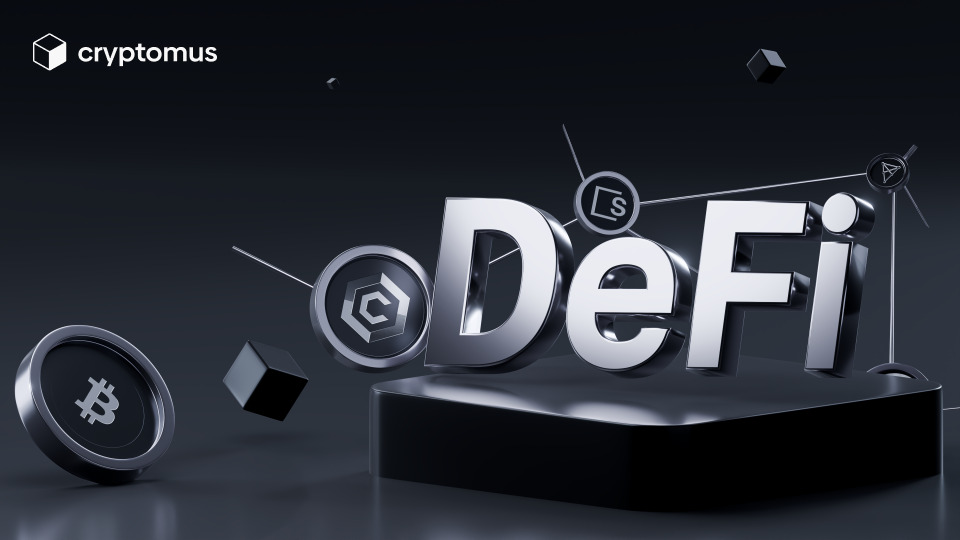
What is DeFi in the Cryptocurrency World
Decentralized finance (DeFi) allows users to trade and earn money on cryptocurrency without involving intermediaries. It is the opposite of the traditional financial system, giving users complete control over their assets. In this article, we look in detail at the concept of DeFi and give examples of popular DeFi platforms and coins for those who are planning to enter this growing field.
What is Decentralized Finance (DeFi)?
Decentralized finance, abbreviated as DeFi, is a blockchain-based financial ecosystem that allows users to manage funds without intermediaries. In other words, they gain access to trading, lending, borrowing, and other processes with crypto without involving banks or payment systems. Instead of the usual middlemen, smart contracts (self-executing programs) come into play, providing automatic transaction execution.
How Does DeFi Work?
DeFi uses blockchain technology: when a user interacts with a DeFi platform (e.g., trades cryptocurrency on an exchange), the transaction is recorded on the blockchain, ensuring its transparency and security. Anyone can track such transactions, but no one can control user activity.
Speaking more about smart contracts, these self-executing programs give users complete control over their assets. This is possible due to securing the system with code — many applications, including exchanges, lending protocols, and income-generating platforms, operate on these codes’ basis. Users connect to smart contracts via crypto wallets (such as Cryptomus wallet), select the desired service (e.g., staking), and interact with the protocol. This peer-to-peer model ensures the DeFi operation 24/7 worldwide.
Most Popular DeFi Platforms
Some DeFi platforms have become critical in the ecosystem — we discuss them further below:
-
Aave. This is a decentralized lending protocol, where users can take out cryptocurrency loans.
-
MakerDAO. The protocol underlying the DAI stablecoin; users generate tokens by locking crypto collateral in smart contracts.
-
Compound. An algorithmic money market protocol, allowing users to borrow and lend crypto assets at interest rates generated by supply and demand.
There are also several decentralized exchanges, which are widely used in DeFi. Popular ones include Uniswap and SushiSwap, having their own tokens to execute transactions.

What Are DeFi Coins?
DeFi involves its coins — these are cryptocurrencies that enable platforms and protocols to function. They are used for various purposes, including paying fees, staking rewards, governance (voting), and providing liquidity.
Here are the most popular DeFi coins on the market:
-
UNI (Uniswap). This is the token of the same-named decentralized exchange, which is used to vote on protocol changes.
-
AAVE (Aave). The token is used for governance and staking in the Aave lending protocol, additionally suitable for reducing fees and ensuring platform security.
-
MKR (MakerDAO). The token manages the Maker protocol, issuing the DAI stablecoin, which holders use to vote on various system parameters.
-
COMP (Compound). The coin is used for the Compound lending and borrowing platform, also giving its holders the opportunity to influence decisions.
-
CRV (Curve DAO Token). Enables the Curve Finance stablecoin exchange to operate and is used for management and staking rewards.
Decentralized Vs. Traditional Finance
Now let's take a look at decentralized and traditional finance side by side. They share one goal — providing financial services, as well as complying with system rules and accepting some risks.
But there are still more differences. Learn them in the table below.
| Aspect | DeFi | Traditional Finance | |
|---|---|---|---|
| Control | DeFiDecentralized, managed by smart contracts | Traditional FinanceCentralized, managed by banks and governments | |
| Funds policy | DeFiHard or impossible to block transactions | Traditional FinanceFunds can be frozen or canceled | |
| Access | DeFiInternet and a crypto wallet are enough | Traditional FinanceRequires identity verification | |
| Working hours | DeFi24/7 | Traditional FinanceLimited | |
| Transparency | DeFiPublic records on the blockchain | Traditional FinancePrivate access with limited records | |
| Intermediaries | DeFiNo, peer-to-peer network | Traditional FinanceOne or several intermediaries |
Risks of DeFi
Despite the great opportunities DeFi offers, it can also carry a number of risks. Keep them in mind before entering the ecosystem:
-
Vulnerability of smart contracts. Since DeFi platforms rely on code, errors in it can lead to loss of funds, and weaknesses can ease hacker attacks.
-
Market volatility. Crypto prices fluctuate constantly, and each platform may have its own exchange rate; this can make it hard to build a workflow.
-
Uncertain regulation. Governments are in the process of defining DeFi-related laws, so regulations may affect availability in some regions.
-
User errors. As in DeFi, users are responsible for their wallets and private keys, and if they lose access, they lose their funds forever.
To prevent risks, it is worth using proven platforms for working with crypto. For example, Cryptomus prevents fraud through KYC procedures and encryption technology, follows AML compliance, and allows two-factor authentication (2FA) for additional account protection.
DeFi is a convenient way to manage money. It gives a complete control over users’ funds and facilitates transactions, but at the same time, it carries risks that they should prevent themselves, too.
Do you still have questions about decentralized finance? Ask them in the comments!
Rate the article








comments
0
You must be logged in to post a comment